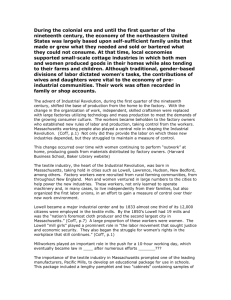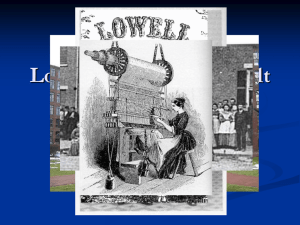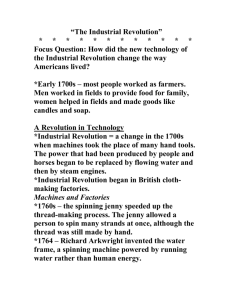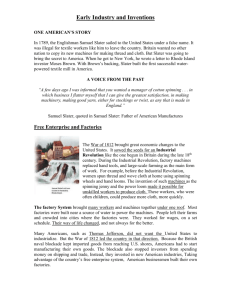Lowell Factory System Sources General context for all sources
advertisement
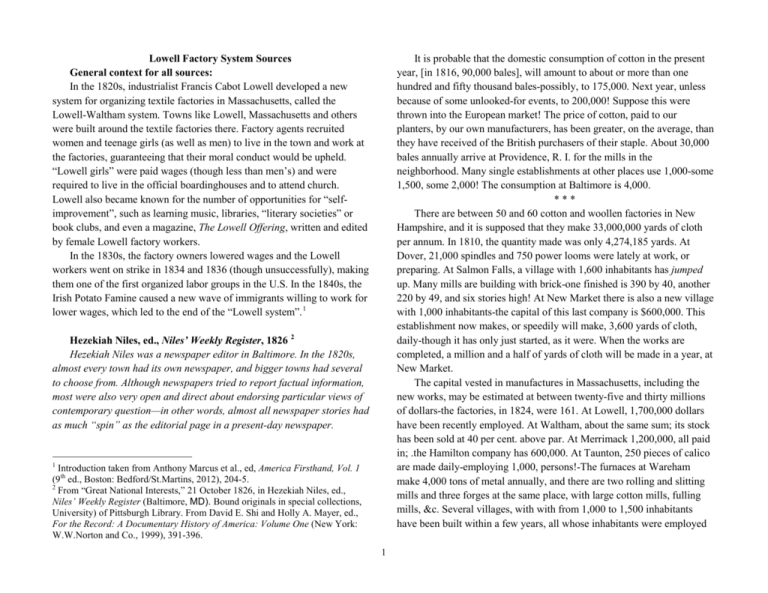
It is probable that the domestic consumption of cotton in the present year, [in 1816, 90,000 bales], will amount to about or more than one hundred and fifty thousand bales-possibly, to 175,000. Next year, unless because of some unlooked-for events, to 200,000! Suppose this were thrown into the European market! The price of cotton, paid to our planters, by our own manufacturers, has been greater, on the average, than they have received of the British purchasers of their staple. About 30,000 bales annually arrive at Providence, R. I. for the mills in the neighborhood. Many single establishments at other places use 1,000-some 1,500, some 2,000! The consumption at Baltimore is 4,000. *** There are between 50 and 60 cotton and woollen factories in New Hampshire, and it is supposed that they make 33,000,000 yards of cloth per annum. In 1810, the quantity made was only 4,274,185 yards. At Dover, 21,000 spindles and 750 power looms were lately at work, or preparing. At Salmon Falls, a village with 1,600 inhabitants has jumped up. Many mills are building with brick-one finished is 390 by 40, another 220 by 49, and six stories high! At New Market there is also a new village with 1,000 inhabitants-the capital of this last company is $600,000. This establishment now makes, or speedily will make, 3,600 yards of cloth, daily-though it has only just started, as it were. When the works are completed, a million and a half of yards of cloth will be made in a year, at New Market. The capital vested in manufactures in Massachusetts, including the new works, may be estimated at between twenty-five and thirty millions of dollars-the factories, in 1824, were 161. At Lowell, 1,700,000 dollars have been recently employed. At Waltham, about the same sum; its stock has been sold at 40 per cent. above par. At Merrimack 1,200,000, all paid in; .the Hamilton company has 600,000. At Taunton, 250 pieces of calico are made daily-employing 1,000, persons!-The furnaces at Wareham make 4,000 tons of metal annually, and there are two rolling and slitting mills and three forges at the same place, with large cotton mills, fulling mills, &c. Several villages, with with from 1,000 to 1,500 inhabitants have been built within a few years, all whose inhabitants were employed Lowell Factory System Sources General context for all sources: In the 1820s, industrialist Francis Cabot Lowell developed a new system for organizing textile factories in Massachusetts, called the Lowell-Waltham system. Towns like Lowell, Massachusetts and others were built around the textile factories there. Factory agents recruited women and teenage girls (as well as men) to live in the town and work at the factories, guaranteeing that their moral conduct would be upheld. “Lowell girls” were paid wages (though less than men’s) and were required to live in the official boardinghouses and to attend church. Lowell also became known for the number of opportunities for “selfimprovement”, such as learning music, libraries, “literary societies” or book clubs, and even a magazine, The Lowell Offering, written and edited by female Lowell factory workers. In the 1830s, the factory owners lowered wages and the Lowell workers went on strike in 1834 and 1836 (though unsuccessfully), making them one of the first organized labor groups in the U.S. In the 1840s, the Irish Potato Famine caused a new wave of immigrants willing to work for lower wages, which led to the end of the “Lowell system”. 1 Hezekiah Niles, ed., Niles’ Weekly Register, 1826 2 Hezekiah Niles was a newspaper editor in Baltimore. In the 1820s, almost every town had its own newspaper, and bigger towns had several to choose from. Although newspapers tried to report factual information, most were also very open and direct about endorsing particular views of contemporary question—in other words, almost all newspaper stories had as much “spin” as the editorial page in a present-day newspaper. 1 Introduction taken from Anthony Marcus et al., ed, America Firsthand, Vol. 1 (9th ed., Boston: Bedford/St.Martins, 2012), 204-5. 2 From “Great National Interests,” 21 October 1826, in Hezekiah Niles, ed., Niles’ Weekly Register (Baltimore, MD). Bound originals in special collections, University) of Pittsburgh Library. From David E. Shi and Holly A. Mayer, ed., For the Record: A Documentary History of America: Volume One (New York: W.W.Norton and Co., 1999), 391-396. 1 many of the very best and most beautiful kinds, were shewn and in astonishing variety and quantity. . . . All these things were, of course, of American manufacture. *** Four thousand weavers find employment in Philadelphia-and several new villages of manufacturers have been built in the neighborhood. Among them Manyunk, with 2,000 inhabitants. The furnaces of Huntingdon county, only, make 6,000 tons of iron, annually. There are 165 hatters in the small town of Reading. The city of Pittsburg contains 1,873 buildings and 12,796 inhabitants. One paper mill employs 190 persons-there are seven other paper mills in the city or its immediate neighborhood-seven rolling and slitting mills; eight air foundries, six steam engine factories, one large wire factory, seven glass works, &c. &c. Some of these are mighty establishments-one of them has two steam engines, of 100 and 120 horse power, to drive the machinery! One of the factories at Pittsburg makes glass to the value of 160,000 dollars a yearand others do nearly as much business. The whole glass manufacture in the United States is worth not less than three millions annually. *** …Before the perfect establishment of the cotton manufacture in the United States, those kind of goods which now sell for 12 cents, cost the consumers 25 cents! Cotton, for the last two or three years, has averaged a greater price for American consumption than it sold for in Europe! Let the planter look to this-it is true. In 1815, in a congressional report, it was estimated that 200,000 persons were employed in the cotton and woollen manufactories of the United States! The present number engaged in all sorts of manufactories cannot be less than two millions. What a market do they create. We shall attempt to calculate it hereafter. The hats, caps and bonnets, of straw or grass, manufactured in the United States, employ about 25,000 persons, chiefly females, and produce $825,000, in Massachusetts, only! The whole value of this manufacture is, probably, about a million and a half yearly. or subsisted by the faetories. A busy, healthful population teems on spots over which a rabbit, a little while since, could hardly have made his way... The manufactories of Rhode Island, Connecticut and Vermont make up a large amount of capital-In Rhode Island there are about ninety cotton mills, and new ones are building! We venture to assert that the surplus product of the people of Rhode Island, aided as they are by scientific power, is of greater value than the surplus products of the whole state of Virginia, in which that power is not much used. By “surplus” I mean a value beyond what is required for the subsistence of the people. One person, assisted by machinery, is equal to from 100 to 200 without it. One hundred and fifty persons are employed in making lace at Newport, R.I. It is made at several other places, splendid, and as good, and at a less price than the imported. Providence is, perhaps, the richest town of its size in the world-and its population rapidly increases. *** Mr. Webster, at a late public dinner, gave the following appropriate and veritable sentiment: “The mechanics and manufacturers of New England-Men who teach us how a little country is to be made a great one.” The females employed in the factories are remarkable for the propriety of their conduct-to be suspected of bad behaviour is to be dismissed.] The cotton and woollen cloths made in New York are valued at from 15 to 18,000,000 dollars per ann. There are large manufactories of iron, wool, cotton, leather, glass, paper, &c. &c. One brewery at Newburg covers 7,500 square feet of ground. Hudson teems with manufacturing establishments, and the splendid cotton and woollen works at Matteawan are famous-they support a large population. Duchess, Oneida and many other counties, are filled with factories. *** A grand display of manufactures has just been made at the Franklin Institute, Philadelphia. It was estimated that the rooms were visited by seven thousand persons in one day, and the crowd was great during the whole time of the exhibition. Cloths, cottons, glass-wares, porcelain, silks, works in wood, in metals, and of almost every description of materials, 2 The quantity of flannel now made in the United States is considerably greater than the whole importation ever amounted to-as reported at the custom houses. Silk begins to be extensively cultivated in several of the states. The silk raised and manufactured in the town of Mansfield, Con. in 1825, was 3,000 lbs. worth $15,000, and in Windham county, in the same state, silk worth 54,000 dollars a year. We have seen fine specimens from North Carolina and one from Missouri. It is a very profitable cultivation, and nearly the whole business is done by women and children, who would otherwise be idle, and so it is pretty nearly a clear gain. One acre of land planted with mulberry trees, will feed as many worms as will make silk worth $200, in a good season. *** …What then would be the state of our country, if our work-shops were in Europe? We should have, as it were, to live in caves and be clothed in skins. But we shall speak of these things hereafter-the whole intent of my present undertaking being to afford some faint idea of the importance of the manufacturing interest, and to show the people what has been done by the encouragement of the national industry, that they may more and more attend to the subject, and resolve that their public agents, whether of the general government or of the states, shall rather accelerate than impede the progress of things so indispensable to the general welfare-so inseparably connected with the employment and profit of every citizen of the United States. There are several factories in Lowell, each of which belongs to what we should term a Company of Proprietors, but what they call in America a Corporation. I went over several of these; such as a woollen factory, a carpet factory, and a cotton factory: examined them in every part; and saw them in their ordinary working aspect, with no preparation of any kind, or departure from their ordinary everyday proceedings. I may add that I am well acquainted with our manufacturing towns in England, and have visited many mills in Manchester and elsewhere in the same manner. I happened to arrive at the first factory just as the dinner hour was over, and the girls were returning to their work; indeed the stairs of the mill were thronged with them as I ascended. They were all well dressed, but not to my thinking above their condition; for I like to see the humbler classes of society careful of their dress and appearance, and even, if they please, decorated with such little trinkets as come within the compass of their means. Supposing it confined within reasonable limits, I would always encourage this kind of pride, as a worthy element of self-respect, in any person I employed;… These girls, as I have said, were all well dressed: and that phrase necessarily includes extreme cleanliness. They had serviceable bonnets, good warm cloaks, and shawls; and were not above clogs and patterns. Moreover, there were places in the mill in which they could deposit these things without injury; and there were conveniences for washing. They were healthy in appearance, many of them remarkably so, and had the manners and deportment of young women: not of degraded brutes of burden… The rooms in which they worked, were as well ordered as themselves. In the windows of some, there were green plants, which were trained to shade the glass; in all, there was as much fresh air, cleanliness, and comfort, as the nature of the occupation would possibly admit of. Out of so large a number of females, many of whom were only then just verging upon womanhood, it may be reasonably supposed that some were delicate and fragile in appearance: no doubt there were. But I solemnly declare, that from all the crowd I saw in the different factories that day, I cannot recall or separate one young face that gave me a painful impression; not Charles Dickens, “General Appearance of Mill Workers,” from American Notes, 1842 3 American Notes is an account of Charles Dickens’ 1842 four-monthlong tour of America. His itinerary included Massachusetts, New York, Pennsylvania, Washington, Baltimore, Virginia, Ohio, Kentucky, Missouri, and Canada. In the following selection, he describes a visit to Lowell. 3 http://www.learner.org/workshops/primarysources/lowell/docs/dickens.html 3 libraries. Thirdly, they have got up among themselves a periodical called THE LOWELL OFFERING, “A repository of original articles, written exclusively by females actively employed in the mills,”-which is duly printed, published, and sold; and whereof I brought away from Lowell four hundred good solid pages, which I have read from beginning to end. The large class of readers, startled by these facts, will exclaim, with one voice, “How very preposterous!” On my deferentially inquiring why, they will answer, “These things are above their station.” In reply to that objection, I would beg to ask what their station is. It is their station to work. And they do work. They labour in these mills, upon an average, twelve hours a day, which is unquestionably work, and pretty tight work too. Perhaps it is above their station to indulge in such amusements, on any terms. Are we quite sure that we in England have not formed our ideas of the “station” of working people, from accustoming ourselves to the contemplation of that class as they are, and not as they might be? … For myself, I know no station in which, the occupation of to-day cheerfully done and the occupation of to-morrow cheerfully looked to, any one of these pursuits is not most humanising and laudable. … I know no station which has a right to monopolise the means of mutual instruction, improvement, and rational entertainment; or which has ever continued to be a station very long, after seeking to do so. Of the merits of the Lowell Offering as a literary production, I will only observe, putting entirely out of sight the fact of the articles having been written by these girls after the arduous labours of the day, that it will compare advantageously with a great many English Annuals. It is pleasant to find that many of its Tales are of the Mills and of those who work in them; that they inculcate habits of self-denial and contentment, and teach good doctrines of enlarged benevolence. A strong feeling for the beauties of nature, as displayed in the solitudes the writers have left at home, breathes through its pages like wholesome village air; and though a circulating library is a favourable school for the study of such topics, it has very scant allusion to fine clothes, fine marriages, fine houses, or fine life. … one young girl whom, assuming it to be matter of necessity that she should gain her daily bread by the labour of her hands, I would have removed from those works if I had had the power. They reside in various boarding-houses near at hand. The owners of the mills are particularly careful to allow no persons to enter upon the possession of these houses, whose characters have not undergone the most searching and thorough inquiry. Any complaint that is made against them, by the boarders, or by any one else, is fully investigated; and if good ground of complaint be shown to exist against them, they are removed, and their occupation is handed over to some more deserving person. There are a few children employed in these factories, but not many. The laws of the State forbid their working more than nine months in the year, and require that they be educated during the other three. For this purpose there are schools in Lowell; and there are churches and chapels of various persuasions, in which the young women may observe that form of worship in which they have been educated. At some distance from the factories, and on the highest and pleasantest ground in the neighbourhood, stands their hospital, or boarding-house for the sick: it is the best house in those parts, and was built by an eminent merchant for his own residence. …The principal medical attendant resides under the same roof; and were the patients members of his own family, they could not be better cared for, or attended with greater tenderness and consideration. The weekly charge in this establishment for each female patient is three dollars, or twelve shillings English; but no girl employed by any of the corporations is ever excluded for want of the means of payment. That they do not very often want the means, may be gathered from the fact, that in July,1841, no fewer than nine hundred and seventy-eight of these girls were depositors in the Lowell Savings Bank: the amount of whose joint savings was estimated at one hundred thousand dollars, or twenty thousand English pounds. I am now going to state three facts, which will startle a large class of readers on this side of the Atlantic, very much. Firstly, there is a joint-stock piano in a great many of the boardinghouses. Secondly, nearly all these young ladies subscribe to circulating 4 In this brief account of Lowell, and inadequate expression of the gratification it yielded me, and cannot fail to afford to any foreigner to whom the condition of such people at home is a subject of interest and anxious speculation, I have carefully abstained from drawing a comparison between these factories and those of our own land. Many of the circumstances whose strong influence has been at work for years in our manufacturing towns have not arisen here; and there is no manufacturing population in Lowell, so to speak: for these girls (often the daughters of small farmers) come from other States, remain a few years in the mills, and then go home for good. richer neighbor could not get the little daughter; and, contrary to all the modern notions about hygiene, we were a healthful and a robust brood…. Shortly after this my mother’s widowed sister, Mrs. Angeline Cudworth, who kept a factory boarding-house in Lowell, advised her to come to that city. She secured a house for her, and my mother, with her little brood and her few household belongings, started for the new factory town…. When we reached Lowell, we were carried at once to my aunt’s house, whose generous spirit had well provided for her hungry relations; and we children were led into her kitchen, where, on the longest and whitest of tables, lay, oh, so many loaves of bread! After our feast of loaves we walked with our mother to the Tremont Corporation, where we were to live, and at the old No. 5 (which imprint is still legible over the door), in the first block of tenements then built, I began my life among factory people…My mother kept forty boarders, most of them men, millhands… I had been to school constantly until I was about ten years of age, when my mother, feeling obliged to have help in her work besides what I could give, and also needing the money which I could earn, allowed me, at my urgent request (for I wanted to earn money like the other little girls), to go to work in the mill. I worked first in the spinning-room as a “doffer.” The doffers were the very youngest girls, whose work was to doff, or take off, the full bobbins, and replace them with the empty ones. I can see myself now, racing down the alley, between the spinning-frames, carrying in front of me a bobbin-box bigger than I was. These mites had to be very swift in their movements, so as not to keep the spinning-frames stopped long, and they worked only about fifteen minutes in every hour. The rest of the time was their own, and when the overseer was kind they were allowed to read, knit, or even to go outside the mill-yard to play. Some of us learned to embroider in crewels, and I still have a lamb worked on cloth, a relic of those early days, when I was first taught to improve my time in the good old New England fashion. When not doffing, we were often allowed to go home, for a time, and thus we were able to help our mothers in their housework. We were paid two dollars a week; and how proud I was when my turn came to stand up Harriet H. Robinson, Loom and Spindle: Or, Life Among the Early Mill Girls, 1898 4 Harriet Robinson worked in the Lowell mills from 1834 to 1848 (from age 10 to 23). She later married and was active in the abolitionist movement and the women’s rights movement. She published this partial autobiography when she was 73 years old. It is partially intended to entertain her readers but she also makes clear comparisons to political issues from “present day” (that is, the 1890s). In 1831, under the shadow of a great sorro w, which had made her four children fatherless,– the oldest but seven years of age,–my mother was left to struggle alone; and, although she tried hard to earn bread enough to fill our hungry mouths, she could not do it, even with the help of kind friends. And so it happened that one of her more wealthy neighbors, who had looked with longing eyes on the one little daughter of the family, offered to adopt me. But my mother, who had had a hard experience in her youth in living amongst strangers, said, “No; while I have one meal of victuals a day, I will not part with my children.”… That was a hard, cold winter; and for warmth’s sake my mother and her four children all slept in one bed, two at the foot and three at the head,–but her 4 Harriet H. Robinson, Loom and Spindle: Or, Life Among the Early Mill Girls, (Boston: Thomas Y. Crowell and Co., 1898). Full text of Robinson’s book is available at http://library.uml.edu/clh/all/han.pdf 5 whipped by their cruel overseers. But we did know of it, and used to sing, to a doleful little tune, some verses called, “The Factory Girl’s Last Day.”… In contrast with this sad picture, we thought of ourselves as well off, in our cosey corner of the mill, enjoying ourselves in our own way, with our good mothers and our warm suppers awaiting us when the goingout bell should ring…. I was a “little doffer” until I became old e nough to earn more money; then I tended a spinning-frame for a little while; and after th at I learned, on the Merrirnack corporation, to be a drawing-in girl, which was considered one of the most desirable employments, as about only a dozen girls were needed in each mill. We drew in, one by one, the threads of the warp, through the harness and the reed, and so made the beams ready for the weaver’s loom… Chapter IV: Characteristics of the Early Factory Girls: When I look back into the factory life of fifty or sixty years ago, I do not see what is called “a class” of young men and women going to and from their daily work, like so many ants that cannot be distinguished one from another; I see them as individuals, with personalities of their own. This one has about her the atmosphere of her early home. That one is impelled by a strong and noble purpose. The other, –what she is, has been an influence for good to me and to all womankind. Yet they were a class of factory operatives, and were spoken of (as the same class is spoken of now) as a set of persons who earned their daily bread, whose condition was fixed, and who must continue to spin and to weave to the end of their natural existence. Nothing but this was expected of them, and they were not supposed to be capable of social or mental improvement. That they could be educated and developed in to something more than mere work-people, was an idea that had not yet entered the public mind. So little does one class of persons really know about the thoughts and aspirations of another! It was the good fortune of these early mill-girls to teach the people of that time that this sort of labor is not degrading; that the operative is not only “capable of virtue,” but also capable of self- cultivation. on the bobbin-box, and write my name in the paymaster’s book, and how indignant I was when he asked me if I could “write.” “Of course I can,” said I, and he smiled as he looked down on me. The working-hours of all the girls extended from five o’clock in the morning until seven in the evening, with one-half hour for breakfast and for dinner. Even the doffers were forced to be on duty nearly fourteen hours a day, and this was the greatest hardship in the lives of these children. For it was not until 1842 that the hours of labor for children under twelve years of age were limited to ten per day; but the “ten-hour law” itself was not passed until long after some of these little doffers were old enough to appear before the legislative committee on the subject, and plead, by their presence, for a reduction of the hours of labor. I do not recall any particular hardship connected with this life, except getting up so early in the morning, and to this habit, I never was, and never shall be, reconciled, for it has taken nearly a lifetime for me to make up the sleep lost at that early age. But in every other respect it was a pleasant life. We were not hurried any more than was for our good, and no more work was required of us than we were able easily to do. Most of us children lived at home, and we were well fed, drinking both tea and coffee, and eating substantial meals (besides luncheons) three times a day. We had very happy hours with the older girls, many of whom treated us like babies, or talked in a motherly way, and so had a good influence over us. And in the long winter evenings, when we could not run home between the doffings, we gathered in groups and told each other stories, and sung the old-time songs our mo thers had sung,… And we told each other of our little hopes and desires, and what we meant to do when we grew up. For we had our aspirations; and one of us, who danced the “shawl dance,” as she called it, in the spinning-room alley, for the amusement of her admiring companions, discussed seriously with another little girl the scheme of their running away together, and joining the circus… I cannot tell how it happerned that some of us knew about the English factory children, who, it was said, were treated so badly, and were even 6 employed to go to other States and to Canada, to collect them at so much a head, and deliver them at the factories… But the early factory girls were not all country girls. There were others also, who had been taught that “work is no disgrace.” There were some who came to Lowell solely on account of the social or literary advantages to be found there. They lived in secluded parts of New England, where books were scarce, and there was no cultivated society. They had comfortable homes, and did not perhaps need the money they would earn; but they longed to see this new “City of Spindles,” of which they had heard so much from their neighbors and friends, who had gone there to work. And the fame of the circulating libraries, that were soon opened, drew them and kept them there, when no other inducement would have been sufficient. The laws relating to women were such, that a husband could claim his wife wherever he found her, and also the children she was trying to shield from his influence; and I have seen more than one poor woman skulk behind her loom or her frame when visitors were approaching the end of the aisle where she worked. Some of these were known under assumed names, to prevent their husbands from trusteeing their wages. It was a very common thing for a male person of a certain kind to do this, thus depriving his wife of all her wages, perhaps, month after month. The wages of minor children could be trusteed... Women’s wages were also trusteed for the de bts of their husbands, and children’s for the debts of their parents…. It must be remembered that at this date woman had no property rights. A widow could be left without her share of her husband’s (or the family) property, a legal “incumbrance “ to his estate. A father could make his will without reference to his da ughter’s share of the inheritance. He usually left her a home on the farm as long as she remained single. A woman was not supposed to be capable of spending her own or of using other people’s money. In Massachusetts, before 1840, a woma n could not legally be treasurer of her own sewing-society, unless some man were responsible for her. The law took no cognizance of woman as a money-spender. She was a ward, an appendage, a relict. Thus it happened, that if a woman did not choose to marry, or, when left a At the time the Lowell cotton-mills were started, the factory girl was the 1owest among women. In England, and in France particularly, great injustice had been done to her real character; she was represented as subjected to influences that could not fail to destroy her purity and selfrespect. In the eyes of her overseer she was but a brute, a slave, to be beaten, pinched, and pushed about. It was to overcome this prejudice that such high wages had been offered to women that they might be induced to become mill-girls, in spite of the opprobrium that still clung to this “degrading occupation.” At first only a few came; for, though tempted by the high wages to be regularly paid in “cash,” there were many who still preferred to go on working at some more genteel employment at seventyfive cents a week and their board. But in a short time the prejudice against factory labor wore away, and the Lowell mills became filled with blooming and energetic New England women…. In 1831 Lowell was little more than a factory village. Several corporations were started, and the cotton-mills belonging to them were building. Help was in great demand; and stories were told all over the country of the new factory to wn, and the high wages that were offered to all classes of work-people,–stories that reached the ears of mechanics’ and farmers’ sons, and gave new life to lonely and dependent women in distant towns and farm houses. Into this Yankee El Dorado, these needy people began to pour by the various modes of travel known to those slow old days. The stage-coach and the canal- boat came every day, always filled with new recruits for this army of useful people. The mechanic and machinist came, each with his home-made chest of tools, and oftentimes his wife and little ones. The widow came with her little flock and her scanty housekeeping goods to open a boarding-house or variety store, and so provided a home for her fatherless children. Many farmers’ daughters came to earn money to complete their wedding outfit, or buy the bride’s share of housekeeping articles. Women with past histories came, to hide their griefs and their identity, and to earn an honest living in the “sweat of their brow .” Single young men came, full of hope and life, to get money for an education, or to lift the mortgage from the home-farm. Troops of young girls came by stages and baggage-wagons, men often being 7 widow, to re-marry, she had no choice but to enter one of the few employments open to her, or to become a burden on the charity of some relative. In almost every New England home could be found one or more of these women, sometimes welcome, more often unwelcome, and leading joyless, and in many instances unsatisfactory, lives. The cotton-factory wa s a great opening to these lonely and dependent women. From a condition approaching pauperism they were at once placed above want; they could earn money, and spend it as they pleased; and could gratify their tastes and desires without restraint, and without rendering an account to anybody…. Josephine L. Baker, Article in The Lowell Offering, 1845 5 The magazine The Lowell Offering began publication in 1842. It was edited and written by Lowell factory employees; it circulated not only in Lowell but to a wider readership. This article appeared in 1845. 6 [see next page for text of article.] 5 From Benita Eisler, ed., The Lowell Offering: Writings by New England Mill Women (1840-1845) (1977; New York: W. W. Norton & Co., Inc., 1998), pp. 7782. 6 Introduction from David E. Shi and Holly A. Mayer, ed., For the Record: A Documentary History of America: Volume One (New York: W.W.Norton and Co., 1999), 391-396. 8 \i * * * The Lowell Offering (1845) 397 the dressing is also done here. The fourth is the "broad weaving-room," and contains between thirty and forty fooms; and broad sure enough they are. Just see how lazily the lathe drags backward and forward, and the shuttle--,.how spitefully it hops from one end of it to the other. But we must not stop longer, or perchance it will hop at us. You look weary; but, never mind! there was an end to Jacob's ladder, and so there is a termination to these stairs. Now if you please we will go up to the next room, where the spinning is done. Here we have spinning jacks or jennies that dance merrily along whizzing and singing, as they spin out their "long yarns," and it seems but pleasure to watch their movements; but it is hard work, and requires good health and much strength. Do not go too near, as we shall find that they do not understand the established rules of etiquette, and might unceremoniously knock us over. We must not stop here longer, for it is twelve o'clock, and we have the "carding-room" to visit before dinner. There are'between twenty and thirty set of cards located closely together, and I beg of you to be careful as we go amongst them, or you will get c;aught in the machi1_1~rr: You walk as though you were afraid of getting blue. Please excuse me, if I ask you not to be afraid. 'Tis a wholesome color, and soap and water will wash it off. The girls, you see, are partially guarded against it, by over-skirts and sleeves; but as it is not fashionable to wear. masks, they cannot keep it from their faces. You appear surprised at the hurry and bustle now going on in the room, but your attention has been so engaged that you have forgotten the hour. Just look at the clock, and you will find that it wants but five minutes to "bell time." We will go to the door, and be ready to start when the others do; and now, while we are waiting, just cast your eyes to the stair-way, and you will see another flight of stairs, leading to another spinning-room; a picker is located somewhere in that region, but I cannot give you a description of it, as I have never had the courage to ascend more than five flight of stairs at a time. And-but the bell rings. Now look out-not for the engine-but for the rush to the stair-way. 0 mercy! what a crowd. JOSEPHINE L. BAKER: FROM There is the "counting-room," a long, low, brick building, and opposite is the «store-house," built of the same material, after the same model. Between them, swings the ponderous gate that shuts the mills in from the world without. But, stop; we must get "a pass,: ere we go through, or "the watchman will be after us." Having obtained this, we will stop on the slight elevation by the gate, and view the mills. The one to the left rears high its huge sides of brick and mortar, and the belfry, towering far above the rest, stands out in bold relief against the rosy sky. The almost innumerable windows glitter, like gems, in the morning sunlight. It is six and a half stories high, and, like the fabled monster of old, who guarded the sacred waters of Mars, it seems to guard its less aspiring sister to the right; that is five and a half stories high, and to it is attached the repair-shop. If you please, we will pass to the larger factory,-but be careful, or you will get lost in the mud, for this ya~d is not laid out in such beautiful order, as some of the factory yards are, nor can it be. We will just look into the fi~st r~om.Jt is used for cleaning cloth.:You see the scrubbing and scourillg-rnachi~es are in full operation, and gigging and fulling are going on in full perfection. As it is very damp, and ~~-.?E~~~perf2!gied by the other half of creation, we will pass on, for fear of incurring their jealousy. But the very appearance might indicate that there are, occasionally, fogs artd clouds; and not only fogs and clouds, but sometimes plentiful showers. In the second room the cloth is "finished," going through the various operatiOns of bui="ling, shearing, brushing, inking, fine-drawing, pressing, and packing for market. This is the_pleasantest room og._the corporation, and consequently they are never in want of help. The shearing, brushing, pressing and packing is done by males;'while the burling, inking, marking and fine~drawing is performed byfemales.JVe will pass to the third room,' called the "cassimere weaving-room," where all kinds of cloths are woven, from plain to the most exquisite fancy. There are between eighty and ninety looms, and part of From David E. Shi and Holly A. Mayer, ed., For the Record: A Documentary History of America: Volume One (New York: W.W.Norton and Co., 1999), 391-396. From Benita Eisler, ed., The Lowell Offering: Writings by New England Mill Women (1840-1845) (1977; New York: W. W. Norton & Co., Inc., 1998), pp. 77-82. 1 ii 11 l 1 I, I: I' I l: Ii I I I '! 398 CHAPTER 12 THE DYNAMICS OF GROWTH I do not wonder you gasp for breath; but, keep up courage; we shall soon be on terra firma again. Now, safely landed, I hope to be excused for taking you into such a crowd. Really, it would not be fair to let you see the factory girls and machinery for nothing. I shall be obliged to hurry you, as it is some way to t~arding-h.ou~e, and we have but thirty minutes from- thTfiine the bell begins to ring till it is done ringing again; and then all are required to be at their work. There is a group of girls yonder, going our way; let us overtake them, and hear what they are talking about. Something unpleasant I dare say, from their earnest gestures ancrcfoude(f brows. "Well, I do think it is too bad," exclaims one. "So do I," says another. "This cutting down wages is not what they cry it up to be. I wonder how they'd like to work as hard as we do, digging and drudging day after day, from morning till night, and then, every two or three years, have their wages reduced. I rather guess it wouldn't set very well." "And, besides this, who ever heard, of such a thing as their being raised again," says the first speaker. "I confess that I never did, so long as I've worked in the mill, and that's been these ten years." "Well, it is real provoking any how," returned the other, "for my part I should think they had made a clean sweep this time. I wonder what they'll do next." "Listeners never hear any good of themselves" is a trite saying, and, for fear it may prove true in our case, we will leave this busy group, and get some dinner. There is an open door inviting us to enter. We will do so. You can hang your bonnet and shawl on one of those hooks, that extend the length of the entry for that purpose, or you can lay them on the banisters, as some do. Please to walk into the filW!!K:.toom; Here are two large square tables, covered with checked clothes and loaded down with smoking viands, the odor of which is very inviting. But we will not stop here; there is the long table in the front room, at which ten or fifteen can be comfortably seated. You may place yourself at the head. Now do not be bashful or wait to be helped, but comply with the oftmade request, "help yourself" to whatever you like best; for ~~_Jiave bµ~ afew minutes allo~d you to spend at the table. The reason why, is because you are a rational,' intelligent, thinking being, and ought to know enough to swallow your food whole; whereas a horse or an ox, or any other dumb beast knows no better than to spend an hour in the useless process of mastication. The bell rings again, and the girls are hurrying to.the mills;_ ·you, I suppose, have seen enough of them for one day, so we will walk up stairs and have a tete-atete. You ask, if there are so many things objectionable, why we work in the mill. Well, simply for this reason,-every situation in life, has its trials which must be borne, and factory life has no more than any other. There are many things we do not like; many occurrences that send the warm blood mantling to the cheek when they must be borne in silence, and many harsh words and acts that are not called for. There are objections also to the number of hours we work, to the length of time allotted to our meals, and to the low wages allowed for labor; objections that must and will be answered; for the time has come when something, besides the clothing and feeding of the body is to be thought of; when the mind is to be clothed and fed; and this cannot be as it should be, with the present system oflabor. Who, let me ask, can find that pleasure in life which they should, when it is spent in this way. Without time for the laborer's own work, and the improvement of the mind, save the few evening hours; and even then if the mind is enriched and stored with useful knowledge, it must be at the expense of health. And the feeling too, that comes over ·us (there is no use in denying it) when we hear the bell calling us away from repose that tired nature loudly claims-the feeling, that we are obliged to go. And these few hours, of which we have spoken, are far too short, three at the most at the close of day. Surely, methinks, every heart that lays claim to humanity will feel 'tis not enough. But this, we hope will, ere long, be don bt:.i.J~!e t~_Qf t Th which and an The ti earn co situatio same when fi to com Besi tions c be foun The ies, to needful ought. The work in operati and wh "City o them in to socie mur, fo * * 399 1. Was there a moral to this story? 2. What ~ticisms did the author have about life and work in Lowell? What did she .£raise! 3. What were some of the different· operations performed to manufacture cloth? 4. Which of the tasks was performed by the minority, the men, in this wprkforce? REVIEW QUESTIONS * phaned brother and sister. For the sake of them, we earnestly hope labor may be reformed; that the miserable, selfish spirit of competition, now in our midst, may be thrust from us and consigned to eternal oblivion. There is one other thing that must be mentioned ere we part, that is the practice of sending ) agents through the country to decoy girls away/ from their homes with the promise of high wages; when the market is already stocked to overflowing. ( This is certainly wrong, for it lessens the value of labor, which should be ev~cld~in~high estimation, as the path marked out by the right hand of GoD, in which man should walk with dignity. THE STILLE AND KRUMME FAMILY: Letters from German Immigrants (1836-43) be done away with, and ~bo.rmadc:;.,,;wJ;i_atiLiliould b~!!:~)11vi~i11g_!O every son and daughter of the hU:E!~E.Ja~ily~ · There is a brighter side to this picture, over which we would not willingly pass without notice, and an answer to the question, why we work here? The time we do have is our own. Th~y.JY,e earn comes· pfom]:itry;-m.ore·scftban in any other situation; and our work, though laborious is the same from day to day; we know what it is, and when finished we feel perfectly free, till it is time to commence it again. Besides this, there are many pleasant associations connected with factory life, that are not to be found elsewhere. There are lectures, evening schools and libraries, to which all may have access. The one thing needful here, is the time to improve them as we ought. There is a class, of whom I would speak, that work in the mills, and will while they continue in operation. Namely, the many who have no home, and who come here to seek, in this busy, bustling "City of Spindles," a competency that shall enable them in after life, to live without being a burden to society,-'-the many who toil on, without a murmur, for the support of an aged mother or or- THE STILLE AND KRUMME FAMILY Letters from German Immigrants (1836-43) When the native labor force proved scarce or recalcitrant, managers hired more immigrants-laborers they did not have to ''protect" as they did when they were the daughters of America's farm families. They could also generally pay such workers less than they did native sons, especially as so many of the immigrants could offer only unskilled labor. There were certainly skilled laborers as well as professionals among the immigrants, but they often faced difficulties in establishing themselves due to American ethnocentrism as well as language and economic problems. Of the two major immigrant groups in the first half of the nineteenth century, Germans, I 11 L II #SVDF#PSMBOEFE"NFSJDB5ISPVHIUIF&ZFTPGJUT1FPQMF1SJNBSZ4PVSDFTJO"NFSJDBO )JTUPSZOEFE/FX:PSL-POHNBO
